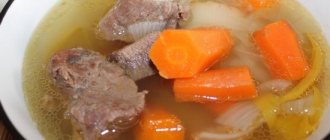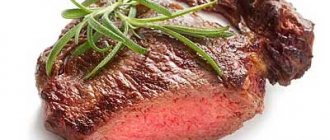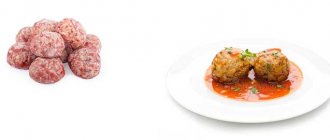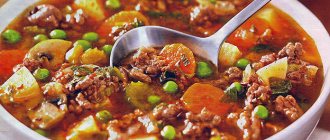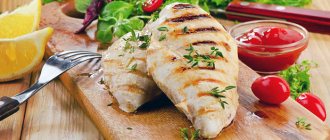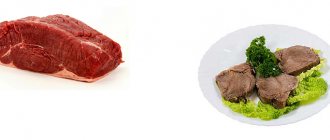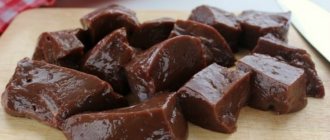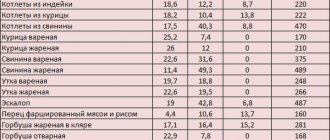Beef is the meat of cattle. In our country, beef is considered to be the meat of a calf or cow. In larger production, cow meat ranks third, making it one of the three most popular types of meat in the world. The meat has a pleasant taste, beef has very little calories, and also has a wonderful aroma.
How to determine what kind of cow meat you are buying?
Everyone should understand that you only need to buy good meat, but not everyone knows how to choose it. Fresh beef meat should have a satisfactory aroma and a unique marbled structure, the color of fresh meat should be deep red (and no other).
In this case, the fat located on the meat should be very soft, the color should be white-cream. When buying beef, you need to feel it: good meat should be elastic both when pressed and when cut. The beef should even shine a little at the cut site. After pressing your finger on the beef, it should level out on its own - this indicates that the meat is really good.
Quite by accident, you can buy meat from an old cow, although you wanted to buy veal. Important! The meat of old cattle has a very dark shade of red, and the fat is covered with a film, the tissues of the meat itself are flabby and inelastic. We will find out further about the calorie content of meat (beef).
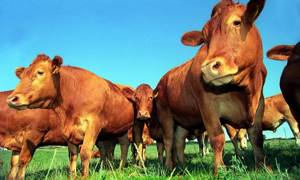
Recipe: Beef stew with onions and carrots. Calorie, chemical composition and nutritional value.
Beef stew with onions and carrots
is rich in vitamins and minerals such as: vitamin A - 12.1%, beta-carotene - 13.1%, vitamin B2 - 14.2%, vitamin B5 - 24.5%, vitamin B6 - 21.9%, vitamin B12 - 42%, vitamin PP - 35.6%, potassium - 13.1%, phosphorus - 23.5%, chlorine - 27%, selenium - 13.6%, zinc - 31.8 %
- Vitamin A
is responsible for normal development, reproductive function, skin and eye health, and maintaining immunity. - B-carotene
is provitamin A and has antioxidant properties. 6 mcg of beta carotene is equivalent to 1 mcg of vitamin A. - Vitamin B2
is involved in redox reactions, helps to increase the color sensitivity of the visual analyzer and dark adaptation. Insufficient intake of vitamin B2 is accompanied by impaired condition of the skin, mucous membranes, and impaired light and twilight vision. - Vitamin B5
is involved in protein, fat, carbohydrate metabolism, cholesterol metabolism, the synthesis of a number of hormones, hemoglobin, promotes the absorption of amino acids and sugars in the intestines, and supports the function of the adrenal cortex. A lack of pantothenic acid can lead to damage to the skin and mucous membranes. - Vitamin B6
is involved in maintaining the immune response, processes of inhibition and excitation in the central nervous system, in the transformation of amino acids, the metabolism of tryptophan, lipids and nucleic acids, promotes the normal formation of red blood cells, and maintaining normal levels of homocysteine in the blood. Insufficient intake of vitamin B6 is accompanied by decreased appetite, impaired skin condition, and the development of homocysteinemia and anemia. - Vitamin B12
plays an important role in the metabolism and transformation of amino acids. Folate and vitamin B12 are interconnected vitamins that are involved in hematopoiesis. A lack of vitamin B12 leads to the development of partial or secondary folate deficiency, as well as anemia, leukopenia, and thrombocytopenia. - Vitamin PP
is involved in redox reactions of energy metabolism. Insufficient vitamin intake is accompanied by disruption of the normal condition of the skin, gastrointestinal tract and nervous system. - Potassium
is the main intracellular ion that takes part in the regulation of water, acid and electrolyte balance, and is involved in the processes of conducting nerve impulses and regulating blood pressure. - Phosphorus
takes part in many physiological processes, including energy metabolism, regulates acid-base balance, is part of phospholipids, nucleotides and nucleic acids, and is necessary for the mineralization of bones and teeth. Deficiency leads to anorexia, anemia, and rickets. - Chlorine
is necessary for the formation and secretion of hydrochloric acid in the body. - Selenium
is an essential element of the antioxidant defense system of the human body, has an immunomodulatory effect, and is involved in the regulation of the action of thyroid hormones. Deficiency leads to Kashin-Beck disease (osteoarthritis with multiple deformities of the joints, spine and limbs), Keshan disease (endemic myocardiopathy), and hereditary thrombasthenia. - Zinc
is part of more than 300 enzymes and is involved in the processes of synthesis and breakdown of carbohydrates, proteins, fats, nucleic acids and in the regulation of the expression of a number of genes. Insufficient consumption leads to anemia, secondary immunodeficiency, liver cirrhosis, sexual dysfunction, and the presence of fetal malformations. Research in recent years has revealed the ability of high doses of zinc to disrupt the absorption of copper and thereby contribute to the development of anemia.
morehide
You can view a complete directory of the healthiest foods in the “My Healthy Diet” app.
Beef calories
Cow meat is the lowest calorie type of meat product in the world. This meat contains very little fat. There is a medium-sized layer of fat in beef, but this is an insignificant inclusion, so this meat can be eaten by everyone (even those on a strict diet).
It is important to know that a cow has different caloric content of meat from different parts of its body. Roughly speaking, cow meat contains from 150 to 500 kcal. 100 grams of beef contains about 187 kcal. Boiled beef has a very low calorie content - only 153 kcal per 0.1 kilogram of meat. Fried has a slightly higher calorie content - 180 kilocalories. In turn, baked beef has a calorie content ranging from 150-350 kcal (depending on spices, additives, etc.).
It is recommended for everyone, without exception, to consume such meat, but in reasonable quantities, of course. Important! Beef is included in the diet of an obese person, since meat contains vitamins, without which it is much more difficult for the human body to withstand a certain load.
Recipe: Beef stew with onions and carrots. Calorie, chemical composition and nutritional value.
Beef stew with onions and carrots
is rich in vitamins and minerals such as: vitamin A - 22.6%, beta-carotene - 23.3%, vitamin B6 - 12.2%, vitamin B12 - 50%, vitamin PP - 24, 5%, phosphorus - 15%, chlorine - 14.4%, cobalt - 48.3%, copper - 12.5%, molybdenum - 14%, zinc - 16.7%
- Vitamin A
is responsible for normal development, reproductive function, skin and eye health, and maintaining immunity. - B-carotene
is provitamin A and has antioxidant properties. 6 mcg of beta carotene is equivalent to 1 mcg of vitamin A. - Vitamin B6
is involved in maintaining the immune response, processes of inhibition and excitation in the central nervous system, in the transformation of amino acids, the metabolism of tryptophan, lipids and nucleic acids, promotes the normal formation of red blood cells, and maintaining normal levels of homocysteine in the blood. Insufficient intake of vitamin B6 is accompanied by decreased appetite, impaired skin condition, and the development of homocysteinemia and anemia. - Vitamin B12
plays an important role in the metabolism and transformation of amino acids. Folate and vitamin B12 are interconnected vitamins that are involved in hematopoiesis. A lack of vitamin B12 leads to the development of partial or secondary folate deficiency, as well as anemia, leukopenia, and thrombocytopenia. - Vitamin PP
is involved in redox reactions of energy metabolism. Insufficient vitamin intake is accompanied by disruption of the normal condition of the skin, gastrointestinal tract and nervous system. - Phosphorus
takes part in many physiological processes, including energy metabolism, regulates acid-base balance, is part of phospholipids, nucleotides and nucleic acids, and is necessary for the mineralization of bones and teeth. Deficiency leads to anorexia, anemia, and rickets. - Chlorine
is necessary for the formation and secretion of hydrochloric acid in the body. - Cobalt
is part of vitamin B12. Activates enzymes of fatty acid metabolism and folic acid metabolism. - Copper
is part of enzymes that have redox activity and are involved in the metabolism of iron, stimulates the absorption of proteins and carbohydrates. Participates in the processes of providing oxygen to the tissues of the human body. Deficiency is manifested by disturbances in the formation of the cardiovascular system and skeleton, and the development of connective tissue dysplasia. - Molybdenum
is a cofactor for many enzymes that ensure the metabolism of sulfur-containing amino acids, purines and pyrimidines. - Zinc
is part of more than 300 enzymes and is involved in the processes of synthesis and breakdown of carbohydrates, proteins, fats, nucleic acids and in the regulation of the expression of a number of genes. Insufficient consumption leads to anemia, secondary immunodeficiency, liver cirrhosis, sexual dysfunction, and the presence of fetal malformations. Research in recent years has revealed the ability of high doses of zinc to disrupt the absorption of copper and thereby contribute to the development of anemia.
morehide
You can view a complete directory of the healthiest foods in the “My Healthy Diet” app.
Types of meat
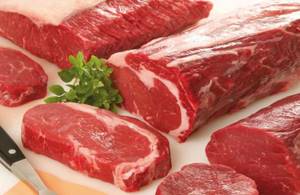
Beef is divided into three grades:
- higher;
- first;
- second grade.
The very first (highest) grade of cow meat includes the breast, as well as the back, sirloin, fillet, rump and rump. The calorie content of all these parts is minimal; in other words, premium beef has the lowest calorie content.
Experts consider the first grade of meat to be the shoulder and shoulder parts of the cow, as well as the so-called flank. This meat will be slightly fattier than the previous one, and accordingly, the calorie content will be slightly higher.
Well, the last grade of beef includes all shanks and cuts. These parts of beef have the highest calorie content.
The most prized beef is from still young heifers and bulls. Of course, such meat costs a little more, but it has an excellent taste.
How to cook?
In cooking, beef stew takes a leading place. There are countless recipes for beef stew. It is prepared both in its own juice and with the addition of spices, oil, and vegetables. Beef stew, both store-bought and home-made, also deserves special attention. The energy value of this product is 212 kcal. It also preserves all vitamins and minerals. This stew is easy to prepare and stores well.
Let's look at the features of preparing beef stew. We offer a recipe for not only tasty, but also healthy meat. First, let's choose a piece of beef. When you bring the meat home, be sure to rinse it with running water and cut it into small pieces. Fry it in a small amount of vegetable oil. After this, fill everything with water and cook for about two hours over low heat. Next, add salt, add bay leaf, allspice and simmer for another 30 minutes.
Place the stew in pre-washed and sterilized half-liter jars, fill it with broth and set to sterilize for 20 minutes. Then we roll it up. For baby and diet food, choose less fatty cuts, add less salt, and limit spices. In the same way, we cook the stew in its own juice without adding oil.
How much does stewed pork cost (average price for 1 jar)?
Moscow and Moscow region.
Pork stew is a meat food product well known to all residents of the post-Soviet space. For quite a long time, in the untouchable stock or in the set of products for the “alarm” suitcase of a citizen of the USSR, of every Soviet family, there was an invariable component - pork stew. Nowadays, no one stores pork stew in boxes in case of natural disasters, war or other troubles.
Stewed pork has moved from military to civilian food. Why is stewed pork so good? Firstly, stew is a canned meat product. During the preservation process, pork meat undergoes heat treatment, so the product perfectly retains all its taste and consumer properties for a large amount of time. Moreover, the shelf life of stewed pork increases if you use iron cans to package the finished product.
What is noteworthy is that usually the shelf life of stewed pork is set by the manufacturer at 2-3 years, no more. History knows of cases where people ate pork stew from an emergency reserve 50 years ago. In addition to excellent consumer qualities, pork stew has excellent satiating abilities.
Useful properties and composition
Cow meat contains not only healthy carbohydrates, proteins and fats, but also many vitamins: A, C, B (1, 2, 6 and 12), PP and E. Do not forget about the mineral salts of magnesium, sodium, potassium, iron, zinc, phosphorus, cobalt, copper and others. It is interesting to know that cow liver contains a lot of iron!
Beef is meat that is a good source of protein, because it contains proteins necessary for human health in large quantities. Most of them are located in beef tenderloin.
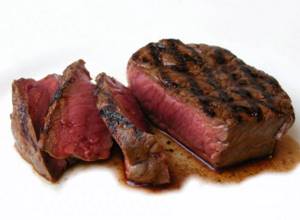
Doctors also recommend consuming beef meat in decent quantities for those people who suffer from a disease such as iron deficiency anemia. If you have high blood cholesterol levels, be sure to eat beef - this will stabilize it a little.
Recipe: Beef stew with carrots and onions. Calorie, chemical composition and nutritional value.
Beef stew with carrots and onions
is rich in vitamins and minerals such as: vitamin A - 26.2%, beta-carotene - 28.3%, vitamin B6 - 15.5%, vitamin B12 - 59.5%, vitamin PP - 27.8%, phosphorus - 17%, iron - 11%, cobalt - 55.5%, copper - 13.8%, molybdenum - 11.4%, chromium - 11.9%, zinc - 19.6%
- Vitamin A
is responsible for normal development, reproductive function, skin and eye health, and maintaining immunity. - B-carotene
is provitamin A and has antioxidant properties. 6 mcg of beta carotene is equivalent to 1 mcg of vitamin A. - Vitamin B6
is involved in maintaining the immune response, processes of inhibition and excitation in the central nervous system, in the transformation of amino acids, the metabolism of tryptophan, lipids and nucleic acids, promotes the normal formation of red blood cells, and maintaining normal levels of homocysteine in the blood. Insufficient intake of vitamin B6 is accompanied by decreased appetite, impaired skin condition, and the development of homocysteinemia and anemia. - Vitamin B12
plays an important role in the metabolism and transformation of amino acids. Folate and vitamin B12 are interconnected vitamins that are involved in hematopoiesis. A lack of vitamin B12 leads to the development of partial or secondary folate deficiency, as well as anemia, leukopenia, and thrombocytopenia. - Vitamin PP
is involved in redox reactions of energy metabolism. Insufficient vitamin intake is accompanied by disruption of the normal condition of the skin, gastrointestinal tract and nervous system. - Phosphorus
takes part in many physiological processes, including energy metabolism, regulates acid-base balance, is part of phospholipids, nucleotides and nucleic acids, and is necessary for the mineralization of bones and teeth. Deficiency leads to anorexia, anemia, and rickets. - Iron
is part of proteins with various functions, including enzymes. Participates in the transport of electrons and oxygen, ensures the occurrence of redox reactions and activation of peroxidation. Insufficient consumption leads to hypochromic anemia, myoglobin deficiency atony of skeletal muscles, increased fatigue, myocardiopathy, and atrophic gastritis. - Cobalt
is part of vitamin B12. Activates enzymes of fatty acid metabolism and folic acid metabolism. - Copper
is part of enzymes that have redox activity and are involved in the metabolism of iron, stimulates the absorption of proteins and carbohydrates. Participates in the processes of providing oxygen to the tissues of the human body. Deficiency is manifested by disturbances in the formation of the cardiovascular system and skeleton, and the development of connective tissue dysplasia. - Molybdenum
is a cofactor for many enzymes that ensure the metabolism of sulfur-containing amino acids, purines and pyrimidines. - Chromium
is involved in the regulation of blood glucose levels, enhancing the effect of insulin. Deficiency leads to decreased glucose tolerance. - Zinc
is part of more than 300 enzymes and is involved in the processes of synthesis and breakdown of carbohydrates, proteins, fats, nucleic acids and in the regulation of the expression of a number of genes. Insufficient consumption leads to anemia, secondary immunodeficiency, liver cirrhosis, sexual dysfunction, and the presence of fetal malformations. Research in recent years has revealed the ability of high doses of zinc to disrupt the absorption of copper and thereby contribute to the development of anemia.
morehide
You can view a complete directory of the healthiest foods in the “My Healthy Diet” app.
Calorie content, composition and beneficial properties of beef stew
Beef stew has a decent calorie content - 232 kcal per 100 grams of finished meat. At the same time, you just can’t help but like the taste of beef.
The following chemical elements are found in stewed beef: nickel and chromium, zinc and copper, magnesium, iron and fluorine, calcium, cobalt and sodium, potassium, chlorine and manganese, as well as sulfur, molybdenum, etc.
Beef stew, whose calorie content is almost 250 kcal per 100 grams of cooked meat, is recommended for people with highly increased activity so that they can restore strength and build muscle mass.

Recipe: Beef stew with onions and carrots. Calorie, chemical composition and nutritional value.
Beef stew with onions and carrots
is rich in vitamins and minerals such as: vitamin A - 13.5%, beta-carotene - 24.1%, choline - 12.3%, vitamin B5 - 11.3%, vitamin B6 - 19 .7%, vitamin B12 - 84.4%, vitamin E - 29%, vitamin PP - 18%, potassium - 14.2%, phosphorus - 24.1%, cobalt - 67.4%, copper - 17.5 %, molybdenum - 14%, chromium - 14.5%, zinc - 24.3%
- Vitamin A
is responsible for normal development, reproductive function, skin and eye health, and maintaining immunity. - B-carotene
is provitamin A and has antioxidant properties. 6 mcg of beta carotene is equivalent to 1 mcg of vitamin A. - Choline
is part of lecithin, plays a role in the synthesis and metabolism of phospholipids in the liver, is a source of free methyl groups, and acts as a lipotropic factor. - Vitamin B5
is involved in protein, fat, carbohydrate metabolism, cholesterol metabolism, the synthesis of a number of hormones, hemoglobin, promotes the absorption of amino acids and sugars in the intestines, and supports the function of the adrenal cortex. A lack of pantothenic acid can lead to damage to the skin and mucous membranes. - Vitamin B6
is involved in maintaining the immune response, processes of inhibition and excitation in the central nervous system, in the transformation of amino acids, the metabolism of tryptophan, lipids and nucleic acids, promotes the normal formation of red blood cells, and maintaining normal levels of homocysteine in the blood. Insufficient intake of vitamin B6 is accompanied by decreased appetite, impaired skin condition, and the development of homocysteinemia and anemia. - Vitamin B12
plays an important role in the metabolism and transformation of amino acids. Folate and vitamin B12 are interconnected vitamins that are involved in hematopoiesis. A lack of vitamin B12 leads to the development of partial or secondary folate deficiency, as well as anemia, leukopenia, and thrombocytopenia. - Vitamin E
has antioxidant properties, is necessary for the functioning of the gonads and heart muscle, and is a universal stabilizer of cell membranes. With vitamin E deficiency, hemolysis of erythrocytes and neurological disorders are observed. - Vitamin PP
is involved in redox reactions of energy metabolism. Insufficient vitamin intake is accompanied by disruption of the normal condition of the skin, gastrointestinal tract and nervous system. - Potassium
is the main intracellular ion that takes part in the regulation of water, acid and electrolyte balance, and is involved in the processes of conducting nerve impulses and regulating blood pressure. - Phosphorus
takes part in many physiological processes, including energy metabolism, regulates acid-base balance, is part of phospholipids, nucleotides and nucleic acids, and is necessary for the mineralization of bones and teeth. Deficiency leads to anorexia, anemia, and rickets. - Cobalt
is part of vitamin B12. Activates enzymes of fatty acid metabolism and folic acid metabolism. - Copper
is part of enzymes that have redox activity and are involved in the metabolism of iron, stimulates the absorption of proteins and carbohydrates. Participates in the processes of providing oxygen to the tissues of the human body. Deficiency is manifested by disturbances in the formation of the cardiovascular system and skeleton, and the development of connective tissue dysplasia. - Molybdenum
is a cofactor for many enzymes that ensure the metabolism of sulfur-containing amino acids, purines and pyrimidines. - Chromium
is involved in the regulation of blood glucose levels, enhancing the effect of insulin. Deficiency leads to decreased glucose tolerance. - Zinc
is part of more than 300 enzymes and is involved in the processes of synthesis and breakdown of carbohydrates, proteins, fats, nucleic acids and in the regulation of the expression of a number of genes. Insufficient consumption leads to anemia, secondary immunodeficiency, liver cirrhosis, sexual dysfunction, and the presence of fetal malformations. Research in recent years has revealed the ability of high doses of zinc to disrupt the absorption of copper and thereby contribute to the development of anemia.
morehide
You can view a complete directory of the healthiest foods in the “My Healthy Diet” app.
Contraindications and harm of beef
It is very important to remember that cow meat also contains purine bases that are dangerous to the body, which can adversely affect the functioning of the entire body. When purine bases are exchanged in the human body, a specific uric acid is formed, a large amount of which contributes to disruption of the functioning of various parts of the body. In addition, when consuming a large amount of meat, the human immune system is simply weakened, thereby reducing the body’s natural ability to resist certain infections and diseases.
Recipe: Beef stew with onions and carrots. Calorie, chemical composition and nutritional value.
Beef stew with onions and carrots
is rich in vitamins and minerals such as: vitamin A - 34.9%, beta-carotene - 37.9%, vitamin B12 - 35.4%, vitamin C - 16.5%, vitamin PP - 18.5%, silicon - 23.4%, phosphorus - 12.2%, cobalt - 45.1%, copper - 12.2%, molybdenum - 11.7%, zinc - 13.7%
- Vitamin A
is responsible for normal development, reproductive function, skin and eye health, and maintaining immunity. - B-carotene
is provitamin A and has antioxidant properties. 6 mcg of beta carotene is equivalent to 1 mcg of vitamin A. - Vitamin B12
plays an important role in the metabolism and transformation of amino acids. Folate and vitamin B12 are interconnected vitamins that are involved in hematopoiesis. A lack of vitamin B12 leads to the development of partial or secondary folate deficiency, as well as anemia, leukopenia, and thrombocytopenia. - Vitamin C
is involved in redox reactions, the functioning of the immune system, and promotes the absorption of iron. Deficiency leads to loose and bleeding gums, nosebleeds due to increased permeability and fragility of blood capillaries. - Vitamin PP
is involved in redox reactions of energy metabolism. Insufficient vitamin intake is accompanied by disruption of the normal condition of the skin, gastrointestinal tract and nervous system. - Silicon
is included as a structural component in glycosaminoglycans and stimulates collagen synthesis. - Phosphorus
takes part in many physiological processes, including energy metabolism, regulates acid-base balance, is part of phospholipids, nucleotides and nucleic acids, and is necessary for the mineralization of bones and teeth. Deficiency leads to anorexia, anemia, and rickets. - Cobalt
is part of vitamin B12. Activates enzymes of fatty acid metabolism and folic acid metabolism. - Copper
is part of enzymes that have redox activity and are involved in the metabolism of iron, stimulates the absorption of proteins and carbohydrates. Participates in the processes of providing oxygen to the tissues of the human body. Deficiency is manifested by disturbances in the formation of the cardiovascular system and skeleton, and the development of connective tissue dysplasia. - Molybdenum
is a cofactor for many enzymes that ensure the metabolism of sulfur-containing amino acids, purines and pyrimidines. - Zinc
is part of more than 300 enzymes and is involved in the processes of synthesis and breakdown of carbohydrates, proteins, fats, nucleic acids and in the regulation of the expression of a number of genes. Insufficient consumption leads to anemia, secondary immunodeficiency, liver cirrhosis, sexual dysfunction, and the presence of fetal malformations. Research in recent years has revealed the ability of high doses of zinc to disrupt the absorption of copper and thereby contribute to the development of anemia.
morehide
You can view a complete directory of the healthiest foods in the “My Healthy Diet” app.
Beef in cooking
Due to the fact that beef has a low calorie content, it is widely used in cooking; many dishes of different types and tastes can be prepared from cow meat. There are a huge number of simple and very popular recipes for this meat, each recipe has been tested more than once by housewives from all over the world - it turns out delicious!
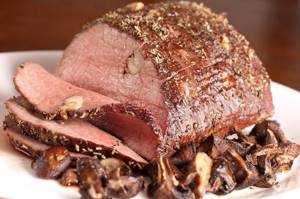
You can make wonderful shish kebab from beef (if you like tough meat), the minced meat for dumplings is made from this meat. The cook recommends making and eating simply fried or baked beef, because the recipes are really very simple, and the taste of the dish is simply unforgettable. Yes, and you can cook something, because boiled beef has a very low calorie content.
We hope everyone found and learned something new from this article. Have a nice day and bon appetit!
Dietary properties:
What calorie content does beef stew have, what dietary properties does it have, all this is of interest to those who lead a healthy lifestyle and monitor their health and figure. So we will try to answer these questions in the next article.

Eating nice cuts of real red meat will not only keep you from adding pounds, but it will also help you lose more than you would without eating meat at all. We don't think you should (or should) eat meat every day before bed, but eating a modest portion for lunch 2-3 times a week is one of the best and surest ways to get quality protein and iron—two nutrients that can make the difference between success and failure. your attempt to lose weight.
Research shows that a diet in which 20-30% of calories are supplied to the body in the form of protein allows for better weight loss and fat loss than diets that contain little protein.
It's no surprise: Protein is incredibly nutritious, helping you feel full on fewer calories and keep your hunger in check for longer.
Delicious recipe! Waffles recipe for a Soviet gas waffle iron
It smooths out spikes in blood sugar and insulin levels, which over time can lead to fat storage, mainly around the waist. By including protein in your diet, you stimulate metabolic processes in the body: about 25 kcal are spent on digesting 100 kcal of protein versus 10–15 kcal for digesting the same amount of fat and carbohydrates. Protein is also essential for maintaining lean muscle while dieting—and the more lean muscle your body has, the more calories it burns while at rest.
Thanks to the presence of iron in meat, you may be more willing to hit the gym, where you can build more lean muscle and thus further boost your metabolism. Red blood cells use iron to deliver oxygen to organs needed to produce energy.
It is known that 9-16% of modern women suffer from anemia, but iron deficiency is observed in a much larger number of women - and this condition, although milder than real anemia, can also cause a lack of energy and a feeling of constant fatigue. Iron is also found in plant foods, but the body absorbs it much more easily from meat. So although a 110-gram serving of meat will only provide you with 2 mg of iron compared to the daily requirement of 18 mg, this amount is quite significant.
Composition of pork stew
This is primarily due to the composition of pork stew, which usually includes the following ingredients: gelled pork meat, onions (fresh or dried), salt, pepper, and bay leaf. The calorie content of pork stew is 367 Kcal. This is a fairly high figure. However, you should not make hasty conclusions and completely exclude the product from your diet just because of the high calorie content of pork stew.
Although pork stew contains up to 53% fat, consuming the product within reasonable limits will not cause significant harm to your health or the beauty and slimness of your figure. True, unscrupulous producers of pork stew often violate the rules and requirements of GOST and add ingredients to the product that are not included in the recipe. It is impossible to guarantee the safety of such a product.
Therefore, it is better to cook pork stew at home, especially in modern times, finding a recipe and all the ingredients for the stew will not be difficult. We invite you to try your hand at making pork stew using the following simple recipe. So, you will need a kilogram of pork fillet, salt, pepper and bay leaf. If you wish, you can add other spices and herbs to the product to taste.
The meat for the stew should be cut into small pieces; the pork should first be washed under running water. Place the chopped meat in a bowl and sprinkle with salt. Then we sterilize the jars and put pepper and bay leaf on the bottom. Place the meat in jars and place in a cold oven. This is a mandatory condition that should not be forgotten. Then we set the temperature sensor to 200 degrees and begin to stew the pork. Usually it takes 3-4 hours, then turn off the oven and leave the meat to simmer inside for a while. At the last stage, close the jars with lids. It is better to store prepared homemade stew in the refrigerator.
